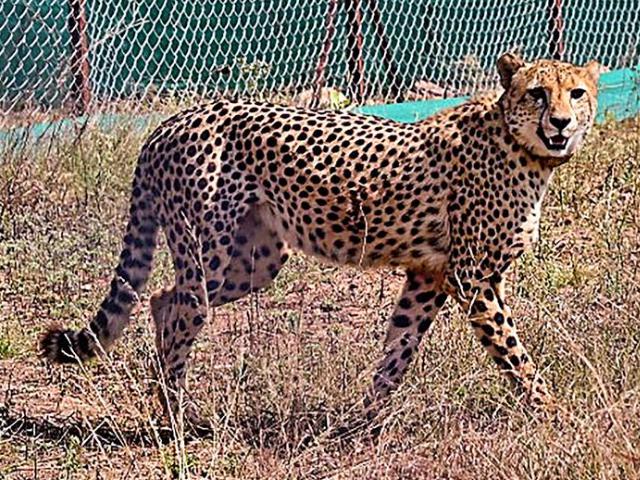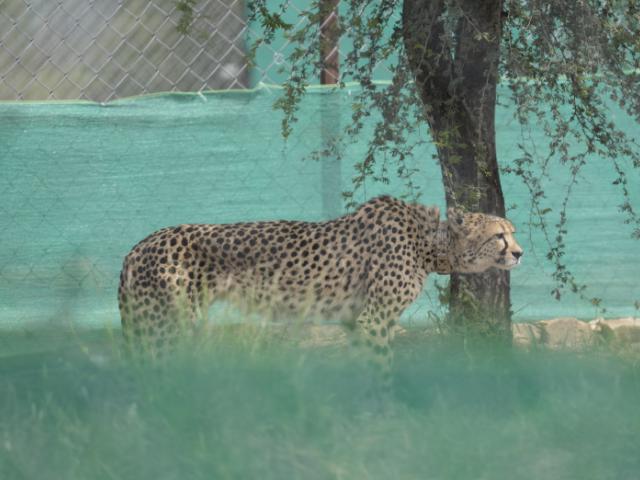First Death In Open Forest
Though high mortality of cheetahs are expected in the project, eight deaths in a span of about 4 months have become a cause of concern for those involved in the cheetah introduction programme termed as “ill -conceived, unscientific and un unplanned” by experts from India and abroad when the cheetah introduction was announced . Except Suraj, all other cheetahs died in enclosures or bomas where they are least expected to die.
Also read: Stressed & Unhappy After Long Captivity , Kuno Cheetahs Need To Be Released In The Wild
"They are safe inside the enclosures where there is no threat of predators like leopards or wolves”, a senior official of the ministry of forest environment and climate change (MoEFC&C) said adding, “ besides, food is also guaranteed inside the enclosures.” Suraj’s death in the open forest might have been caused after fighting with a leopard, he said. “There were injury marks on his back and around neck”, he said. The cat was found dead around 9 am by the monitoring team of Kuno. After Suraj’s death the number of free ranging cheetahs in Kuno becomes 11. Other four felines and a cub are currently in the enclosures. As this cub is being bred in captivity , it will not be a part of the project in future. In all there were 20 cheetahs- 8 were translocated from Namibia in September last year while 12 were airlifted from South Africa in February this year.
"Tejas Died Slowly, Septicaemic Shock"
Meanwhile ,the post mortem report of Tejas, the cheetah who died in an enclosure two days ago, revealed that the cat was “ weak and ailing ” and may have died because of a “traumatic shock” triggered by injuries from a violent interaction with a female cheetah also present in the same enclosure. The report said “There was accumulation of chicken fat ( medical terminology for a variety of fat) and coagulated blood was also found in the aorta and auricle of his heart. His kidney appeared pulpy and emphysema and white coloured nodules were found in spleen,” the post mortem report revealed according to the officials. Member of Cheetah Project Steering Committee Professor Adrian Tordiffe, who is also director - Veterinary Academic Hospital in Pretoria university thinks otherwise. He claimed , “ the animal died slowly and the cause of death was most likely septicaemic shock”. Decoding the post mortem report , the eminent veterinarian said, “ A chicken fat clot in the heart, better described as an agonal clot, simply means that the animal died slowly, as would be the case if it was in a state of severe shock. It does not mean that there was anything wrong with its heart.” The kidneys look pretty normal .The white lumps in the spleen are myelolipomas, often seen in cheetahs. They are benign and do not cause any problems, he told thewildlifeindia.com . “The skin around the neck area appeared to be rotten or infected even though the wounds were not very deep. There were a large number of fly larvae visible on the neck”, he pointed out.
Also read: Adventures of Asha, Oban Put Cheetah Task Force in a Fix
“Since the carcass was placed in a freezer soon after death (according to the authorities at Kuno), these fly larvae must have been present on the animal prior to death. That would mean that there must have been open wounds on the neck area and a discharge which would attract the flies”. “Overall it seems to me that the neck wounds on this cheetah were present for some time (perhaps a few days) prior to his death and that the cause of death was most likely septicaemic shock”, he concluded. He also rued ,” I also need to add that I was notified of a Cheetah Project Steering Committee meeting that would take place today in New Delhi. I asked to attend the meeting virtually, but got no response to my request.” Tejas was so weak that he weighed almost 20 kgs less than the cats of his age. Weighing 43 kgs at the time of autopsy, it was found that his lungs, heart, spleen, and kidney were not normal during the autopsy on Wednesday, (July 12).
Also read: A Tiger Procession in Ranthambhore
“This cheetah was destined to die and would have not been able to survive in the wild. Even inside the enclosure, the cheetah was hardly eating. Though the cat had made a kill, his consumption was not known”, revealed an official of the MoEFC&C. Tejas’ death has brought back the issue of long captivity of the animals . It has already been over a year long captivity for the south African cheetahs who are yet to be released in the wild. “They are not happy, under stress and turning weak”, experts said. They need to be released immediately, they said. But where ? All in Kuno or some other forest of India?
Is Cheetah Action Plan derailed ?
The cheetah action plan envisaged more sites ( jungles) for the cheetah translocation, atleast " three to five”, said YV Jhala, former dean of Dehradun-based Wildlife Institute of India's (WII) . His tenure in the cheetah project was cut short . After Jhala’s departure, the project doesn’t have a genuine cheetah expert. Talking to the news agency PTI, Jhala said, “ Cheetah deaths in Kuno are not that important for the success of the project. What is urgently required is the preparation of other sites for the release of the cheetahs.” A minimum of three-to five sites like Kuno are required for the cheetah reintroduction project to succeed in India, with a proper budget allocation by the central government, Jhala said. The plan mentioned jungles like Gandhi Sagar and Nauradehi sanctuaries in Madhya Pradesh and Mukundara Hills national park in Rajasthan.
Also read:More Questions On Cheetah Project in Kuno
But the idea of sending cheetahs to Mukundara seems to have been dropped after “ political differences” with the state’s government while Gandhi Sagar and Nauradehi are yet to be prepared. Fencing work started in Gandhi Sagar in Neemuch district of MP but the villagers started protesting. Besides, the monsoon also hampered the work. Meanwhile the Kuno river in the Kuno national park and other water bodies have turned this southern tropical dry deciduous forest a hostile place for the ground staff to monitor the cheetahs. International attention and media reports after each cheetah death have also exerted pressure not only on the ground staff in Kuno.





Comments
Post a Comment